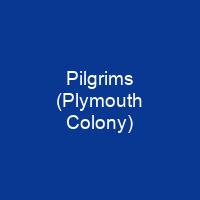Pilgrims were English Puritans who fled religious persecution in England for the tolerance of 17th-century Holland in the Netherlands. They held many of the same Puritan Calvinist religious beliefs but, unlike most other Puritans, maintained that their congregations should separate from the English state church. After several years living in exile in Holland, they eventually determined to establish a new settlement in the New World. They established Plymouth Colony in 1620. The Pilgrims’ story became a central theme in the history of the United States.
About Pilgrims (Plymouth Colony) in brief
 Pilgrims were English Puritans who fled religious persecution in England for the tolerance of 17th-century Holland in the Netherlands. They held many of the same Puritan Calvinist religious beliefs but, unlike most other Puritans, maintained that their congregations should separate from the English state church. After several years living in exile in Holland, they eventually determined to establish a new settlement in the New World. They established Plymouth Colony in 1620. The Pilgrims’ story became a central theme in the history and culture of the United States. The core of the group was brought together around 1605 when they quit the Church of England to form Separatist congregations in the Nottinghamshire, in the East Midlands of England, led by John Robinson, Richard Clyfton, and John Smyth. Their congregations held Brownist beliefs—that true churches were voluntary democratic congregations, not whole Christian nations—as taught by Robert Browne, John Greenwood, and Henry Barrow. The Seditious Sectaries Act of 1593 was specifically aimed at outlawing the Brownists. Under the Act of Uniformity 1559, it was illegal not to attend official Church ofEngland services, with a fine of one shilling for each missed Sunday and holy day. The penalties included imprisonment and larger fines for conducting unofficial services. The same year, Richard Bancroft became Archbishop of Canterbury and launched a campaign against Puritanism and the Separatists. He suspended 300 ministers and fired 80 more, which led some of them to found moreSeparatist churches.
Pilgrims were English Puritans who fled religious persecution in England for the tolerance of 17th-century Holland in the Netherlands. They held many of the same Puritan Calvinist religious beliefs but, unlike most other Puritans, maintained that their congregations should separate from the English state church. After several years living in exile in Holland, they eventually determined to establish a new settlement in the New World. They established Plymouth Colony in 1620. The Pilgrims’ story became a central theme in the history and culture of the United States. The core of the group was brought together around 1605 when they quit the Church of England to form Separatist congregations in the Nottinghamshire, in the East Midlands of England, led by John Robinson, Richard Clyfton, and John Smyth. Their congregations held Brownist beliefs—that true churches were voluntary democratic congregations, not whole Christian nations—as taught by Robert Browne, John Greenwood, and Henry Barrow. The Seditious Sectaries Act of 1593 was specifically aimed at outlawing the Brownists. Under the Act of Uniformity 1559, it was illegal not to attend official Church ofEngland services, with a fine of one shilling for each missed Sunday and holy day. The penalties included imprisonment and larger fines for conducting unofficial services. The same year, Richard Bancroft became Archbishop of Canterbury and launched a campaign against Puritanism and the Separatists. He suspended 300 ministers and fired 80 more, which led some of them to found moreSeparatist churches.
Many Puritans had hoped that reforms and reconciliation would be possible when James came to power which would allow them independence, but the Hampton Court Conference of 1604 denied nearly all of the concessions which they had requested—except for an updated English translation of the Bible. In 1604, the Archbishop began a campaign to purge the archdiocese of non-conforming influences including Puritans and those wishing to return to the Catholic faith. He is credited with driving people out of the country who refused to attend Anglican services. After a time, he arranged for a congregation to meet privately at the Scoby manor house in Lincoln, Lincolnshire, with John Robinson as pastor. He had begun participating in services and had been impressed by John Clyftson’s services. He was later appointed as postmaster for the village and bailiff to the Archbishop of York. He made a covenant with God to walk in all his ways made known, or to be madeknown, unto them, according to their best endeavours, whatsoever it should cost them, the Lord assisting them. He wrote to Robert Cecil, Secretary of State to James I in 1604: The Puritans though they differ in Ceremonies and accidentes, yet they agree with us in substance of religion, and I thinke all or the moste parte of them love his Majestie, and the presente state. But the Papistes are opposite and contrarie in very many substantiall pointes of religion.
You want to know more about Pilgrims (Plymouth Colony)?
This page is based on the article Pilgrims (Plymouth Colony) published in Wikipedia (as of Dec. 10, 2020) and was automatically summarized using artificial intelligence.







